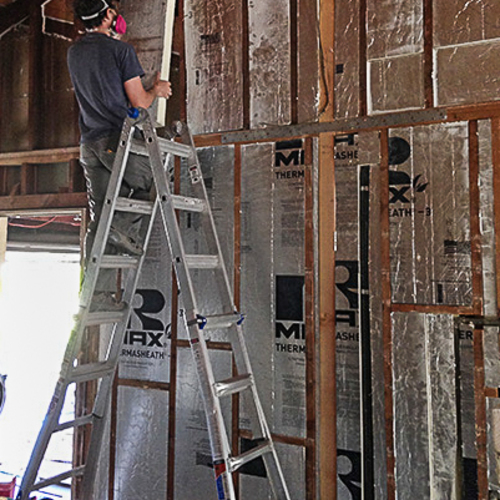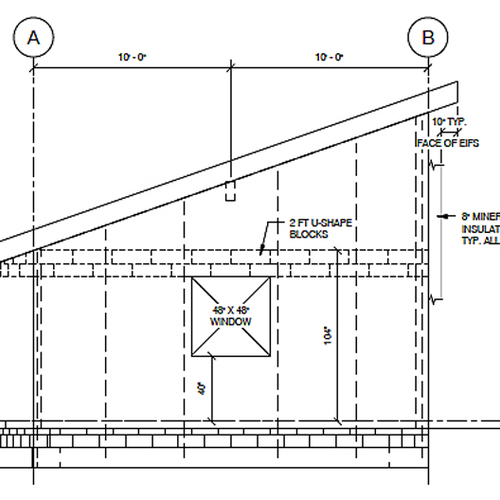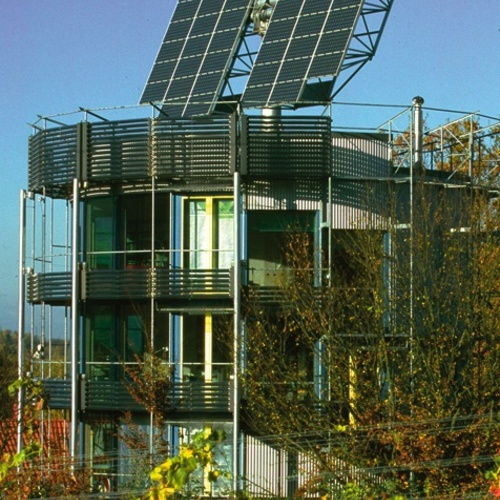Image Credit: Patrick Flood
Image Credit: Patrick Flood The two sides of Jon Flood's new house are symmetrical. Flood specified Zip System sheathing for the walls and roof.
Image Credit: Patrick Flood Double-stud walls. Insulated to an approximate R-value of 68, the exterior walls on the Passivhaus side consist of 2x6 and 2x4 framed walls and a combination of rigid foam, spray foam, and blown-in fiberglass insulation.
Image Credit: Patrick Flood
There was just one thing that Jon Flood didn’t like about the old houses he and his wife had lived in over the years: it took too much energy to keep them comfortable.
“I’ve always been an advocate of frugal living,” the 74-year-old retired educator from Fond du Lac, Wisconsin, said recently. “I’ve never lived in a brand new home. My wife and I, when we were first married, lived in a log cabin, and we progressed to our current home, which was built in 1909. We loved all the old houses we lived in, but as I grew older I began to realize they were very expensive automobiles, so to speak, to drive.”
When his son suggested several years ago they build a new house, the idea was appealing on more than one level. Flood began reading up on energy-efficient construction methods, and soon realized that building a new house not only provided an opportunity to live more comfortably, but would also be a way to demonstrate to a new generation of builders and homeowners how much energy could be saved with state-of-the-art construction.
He decided to split the 2,370-square-foot house into two parts. Half would be built to meet Energy Star requirements, the other half to the much tougher Passivhaus standard.
Although Flood’s wife died, he pressed ahead with the project, and with the help of his photojournalist son Patrick is documenting the construction process. Patrick has taken both still photos and video footage of the project, some of which has been published in the local newspaper.
Flood will move into the new house next April.
“We’re used to wasting money”
Flood’s interest in efficiency goes back a long way. He read the 1984 report on government waste written by the Grace Commission, and later investigated the cost of heating government buildings in Wisconsin. (“Astronomical,” he says.)
When it came to the houses he had been living in, Flood saw very little difference between the way houses were built in 1909 and the way they’re typically built today. High school level construction courses in Wisconsin seemed to have essentially the same curriculum it did a century ago, he said.
He compared that with the spread of Passivhaus construction in Europe, where thousands of these very tight, energy-efficient homes have been built. “The United States is very much behind Europe,” he said, “but that’s not surprising because Europeans have been paying through the nose for energy for 40 or 50 years. We’re used to wasting energy.”
His new home project blossomed into both an opportunity to educate others, and a chance to show the differences in energy consumption between different types of construction. A video produced by Flood and his son will be offered to the local school district.
Builder is coaxed back from retirement
Dave Flagstad had built more than 100 houses over his career, and at the age of 65 had been starting to think about retirement when Flood’s project came along. Although he has known about the building techniques that Flood intended to use, Flagstad had never had the chance to build a house exactly like this one. He signed on as general contractor.
On the Passivhaus side of the house, Flagstad used double stud-wall construction incorporating a 3/4-inch sheets of foil-faced polyisocyanurate foam insulation and 1 1/2-inch thick Zip System insulated sheathing on the outside; then a 2×6 wall with the outer 2 inch sprayed with closed-cell foam, and an inner 2×4 stud wall. The walls have a total of 11 inches of blown-in fiberglass insulation, for an overall R-value of R-68.
Ceilings have 2 inches of closed-cell foam followed by 32 inches of blown-in fiberglass, which Flagstag estimated at an overall R-value of 100-plus.
The house has a full basement. Footings and exterior foundation walls are wrapped in 2 inches of XPS foam, with 4 inches of rigid foam under the slab. On the inside of the foundation walls, Flagstad sprayed 2 inches of closed-cell foam, followed by a 2×4 wall filled with R-13 fiberglass batts.
Windows are triple-glazed Marvin tilt-and-turns. This portion of the house is heated and cooled with a single-head ductless minisplit heat pump.
The Energy Star side of the house gets the same air-sealing and exterior foam detailing, a single 2×6 wall with the same closed-cell foam detail, and 3 1/2 inches of blown-in fiberglass insulation. It’s heated with a forced-air propane furnace. Windows are double-glazed, a mix of double-hung and casements.
Flagstad said the house has been blower-door tested to 0.2 air changes per hour at a pressure difference of 50 pascals, an extremely low rate of air leakage.
Costs estimated at $401,000
Building costs were about $401,000, Flagstad said, or about $169 a square foot, which included some site work as well as building construction. Costs could have been lower, but Flood wanted some nonstandard detailing, such as 12-inch concrete walls in the foundation, a hedge against foundation cracks that are not uncommon in this area of clay-rich soils, and a lifetime asphalt roof.
Flood, a woodworker, also said he didn’t want any plastic lumber in the house and was opting for oak detailing instead, including an oak library he was building himself.
Each side of the house has its own 200-amp electric service and meter. Flood plans to live in the Passivhaus side of the building, which includes a bedroom, bathroom, living room, and the kitchen. On the non-Passivhaus side, the house includes a more formal entry, two bedrooms, a laundry, another bathroom and the library.
Weekly Newsletter
Get building science and energy efficiency advice, plus special offers, in your inbox.
















One Comment
Beautiful home
Scott and Jon,
I meant to comment when this was first posted. I think the concept of your home as a classroom is wonderful. And I am certainly jealous of R-68 walls. We're working on my brother's house and about the best I could manage is a R-35 wall. I am in a much more moderate climate though - South Carolina. Anyway, I applaud your efforts and look forward to hearing more about the house.
Log in or create an account to post a comment.
Sign up Log in